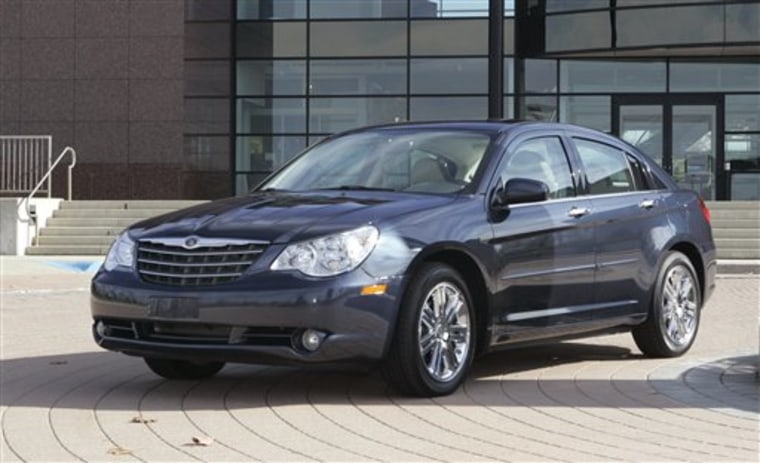In showrooms across the nation, consumers lured by lower gas prices started buying trucks and sport utility vehicles again last month, ending — for now — a yearlong slump that has piled up losses at the domestic Big Three automakers.
Chrysler, Ford and GM have been struggling to match the offerings of Asian competitors as consumer tastes have shifted toward smaller, more fuel-efficient vehicles. But cheaper gas and automaker incentives appear to be changing the mix somewhat.
General Motors Corp. led the industry in October with a 17.3 percent sales increase compared with last year. Sales of GM trucks and SUVs leaped 33.2 percent.
In fairness, the comparison figures were relatively easy to beat. October 2005 was dismal for GM and the other major automakers, which had a hangover from a summer of huge discounts.
Even so, Toyota Motor Corp., Ford Motor Co. and Nissan Motor Co. joined GM in posting gains, Toyota at 9.2 percent, Ford at 8 percent and Nissan at 3.9 percent, according to sales figures released by the companies Wednesday.
Honda Motor Co. and DaimlerChrysler AG reported sales declines, but all major manufacturers saw increased truck sales.
Overall, U.S. consumers bought just over 1.2 million vehicles last month, a 6.1 percent increase above October of last year.
“It’s a combination of the gas price decline and also the increased incentive spending for larger vehicles,” said Jesse Toprak, chief economist for Edmunds.com, a research site for car buyers. He said the trend toward increased truck sales is likely to continue at least into January.
On average, the industry gave buyers incentives worth $4,800 per vehicle on large SUVs in October, and $4,500 on large trucks, Toprak said. Meanwhile, small cars, which generate lower profits for the industry, had an average incentive of just $700.
Paul Ballew, GM’s chief of global market and industry analysis, said the decline in gas prices from a peak of $3 a gallon earlier this year helped the industry as a whole and truck sales in particular.
“What we’re seeing right now is not a movement back into (SUVs), but at $2.20 a gallon, some of the pressure which was really dampening demand ... has been lessened,” he said. “We are not seeing the mass migration out of (SUVs) into cars or crossovers that we saw in the spring.”
GM, he said, spent $300 less per vehicle on incentives last month than it did in September, although it raised incentives by about $200 on full-size SUVs.
DaimlerChrysler, meanwhile, reported that its sales dropped 1.6 percent, due mainly to a 3.2 percent drop at the U.S.-based Chrysler Group. That was partly offset by a 12.3 percent increase at Mercedes-Benz, which posted a record October sales figure.
Toyota and Lexus sold 4.3 percent more cars last month, with truck sales were up 16.3 percent. The company’s performance, though, wasn’t enough to unseat Ford as the No. 2 vehicle seller in the U.S.
Ford sold a total of 214,806 vehicles in October, compared with Toyota’s 189,011. GM sold 297,401.
Ford’s U.S. sales increase was due mostly to a 22.1 percent increase in car sales. Sales of trucks and sport utility vehicles inched up 0.8 percent from the year-ago period. The figures include the Ford, Lincoln, Mercury, Jaguar, Volvo and Land Rover brands.
At Honda, sales were down 0.2 percent in October, with trucks up 11.1 percent and cars down 8.8 percent.
Nissan’s increase was due in large part to an 8.2 percent increase in truck sales. The company also saw a slight 0.1 percent rise in car sales for its Nissan and Infiniti brands.
Chrysler’s car sales were down 33 percent, while its truck sales were up 9.2 percent. The company sold 159,586 vehicles last month, compared with 164,814 in 2005.
Both GM and Chrysler said car sales dropped in part due to reduced sales to rental car companies and other fleet buyers. Automakers have been trying to wean themselves off fleet sales because they yield less money than selling to individuals.
Having long relied on high-margin pickups and SUVs for most of their sales, the Big Three are now trying to cope with huge inventories by slashing production.
Ford said that its Ford, Lincoln and Mercury inventories were estimated at 622,000 at the end of October — 107,000 units fewer than a year ago and 30,000 fewer than at the end of September. The company said it estimates that three-quarters of its inventory is new 2007 models.
Ford sales analyst George Pipas said the automaker’s inventory split between new and old models may have brought down last month’s sales, which were made up of 37 percent old models and 63 percent new ones. A more typical October ratio is 50-50, he said.
“In October, from a sales standpoint, it kind of hurts you if you have insufficient old models, but from a long-term perspective we’re in a much stronger position,” he said.
General Motors shares fell 27 cents, or 0.8 percent, to close at $34.65 on the New York Stock Exchange, while Ford shares rose 24 cents, or 2.9 percent, to $8.52. DaimlerChrysler’s U.S. shares rose 83 cents, or 1.5 percent, to $57.76.
